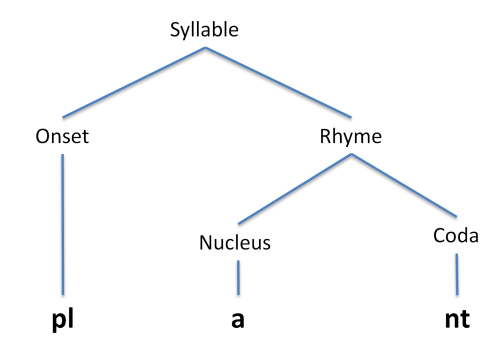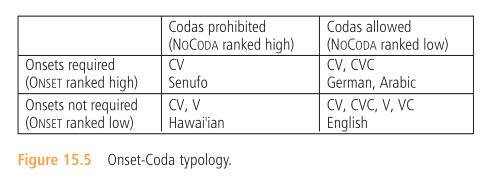Reading quiz qns
- Stress can be the only distinction between two words in a language
- True
- There are no languages in which sounds that are [−son] can occur as sonority peaks. T/F?
- False (e.g. greek psy)
- Which of the following words contains a closed syllable?
- Closed syllable: Syllable with a coda
- Which of the following is true about onsets and codas in different languages? (all the following are poss options)
- No language forbids onsets
- No language requires codas
- Languages may prioritize constraints
- Tends to avoid long vowel sequences without intervening constants.
- The English stress pattern is best characterized as …
- Quantity sensitive
- Partly a lexical stress system: memorize the stress as you learn the meaning
- Mostly a paradigmatic: stress pattern depends on morphological information
- Predictable parts of English is still very complex
Syllables
A syllable is a unit of sound composed of
- a central peak of sonority (usually a vowel), and
- the consonants that cluster around this central peak.
Principles:
- Sonority Sequencing Principle (SSP)
- Should have rising sonority before the peak
- Should have falling sonority after the peak
- Priority of onsets principle (POOP)
- Put as many consonants into next syllable’s onset as possible
- Crosslinguistically, languages prefer syllables of CV type.
- No language requires codas
- No language forbids onsets


Suprasegmental: organization on the layer above the segments.
It seems intuitive for most humans to count syllables. But it is hard to define.
It also seems to be the appropriate unit for
- Phonological generalizations
- Basis of alternations
- The environment ${#, C}$ appears in many languages (i.e. at the word final position or before a consonant.)
- This environment isn’t a natural class
Sonority sequencing principle
Sonority scale:
- Low vowels
- Mid vowels
- High vowels and glides
- Rhotics
- Laterals
- Nasals
- Fricatives
- Plosives
exceptions: Some languages have sonority-violating syllables (sprints, sixths)
- Possible Explanation: Special rule allowing violation at word edges not internally
Syllables organize segments around peak of sonority .
- Onset: preceding consonants
- Nucleus: Highest sonority (peak)
- Coda: following consonants
- Least marked syllable: CV (with onset, without coda)

Syllable weight
Possible constraints/alternations:
- Closed syllable shortening
- Minimal word constraint (move onsets to coda to fill up a threshold of mora)
Constraints on how many elements in the rhyme (nucleus + coda).
Mora: unit of syllable weight
- “V:” : 2 mora
- $V_\text{diphthong}$ : 2 mora
- “V” : 1 mora
- “C” : 1 mora
- In some languages even coda consonants don’t get mora
-
Onsets do not get mora.
- Heavy syllable:
- Coda or Long Vowel present
- Long vowel: Tense vowels/Diphthongs
- Light syllable:
- no coda, short vowel for nucleus
- Heavy syllable more likely to be stressed
Stress
Stress is demarcative: main stress occurs near word edges to definte the boundaries
Stress is sometimes contrastive (e.g. between vowels and nouns with the exact same segments).
Stress to weight principle: A stressed syllable must be heavy.
Stress Rules
Compound tress rule:
- leftmost unit (exact placement subject to language specific rules) of a compound (morpheme with >1 word) gets the stress
- Compound: word combination is not literal modifying
- (lighthouse)
- (lighthouse keeper)
- (heavy metal)
Nuclear stress rule
- rightmost unit of a phrase gets the stress
- Phrase: word combination is “literal modifying” (as in changing the properties via adjective etc.)
- (light) (house)
- (light) (housekeeper)
- (heavy) (metal)
- (Buddhist) (heavy metal)
Lexical stress system
Unpredictable stress. e.g. Russian
Positional stress system
Completely predictable. e.g.
- Czech/Finnish/Georgian: stress always inital.
- French: stress final
- Polish: stress penult
- No language consistently stresses the middle syllable of all words
Paradigmatic stress system
Depends on morphological information.
- English: main stress never moves more than 3 syllables from right edge.
- No phonological rule to explain e.g. [banana]
- Verbs/Adj tend to have stress on the final syllable [reject, insult]
- Nouns on the penult [sculpture, reject, insult]
Rhythmic stress patterns
English stress patterns
Nouns:
- Ignore final syllable if not monosyllabic
- If penult is heavy, stress penult
- else stress antepenult
Verbs/Adjectives:
- Ignore final consonant if any
- if final (rime - 1 consonant) is still heavy, stress final
- e.g. Long vowel (includes tense vowel)
- e.g. Short vowel + rest of consonant cluster
- else stress penult
Stress clash: when two adjacent syllables across a word boundary are stressed: stress shift the first primary stress backwards
Words with affixes and Lexical Phonology
Tonic suffix: the suffix itself is stressed
Neutral suffix: no change
Post-tonic suffix: stress coming immediately before the suffix is stressed
Lexical Phonology
Dividing the lexicon into separate modules/levels:
- different phonological rules for each level



